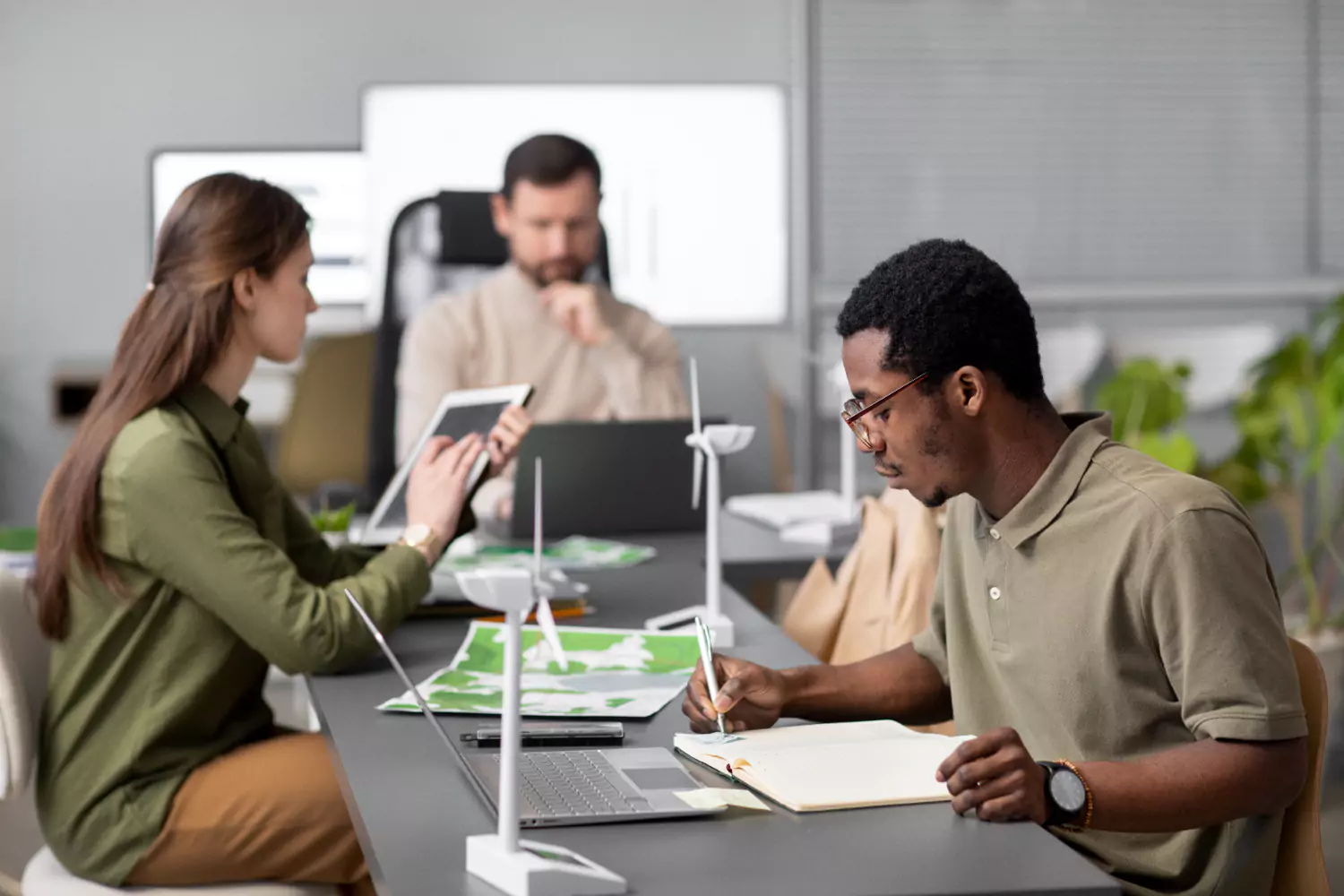Unlocking Business Potential: The Strategic Value of Partnering with Design Agencies
Unlocking Business Potential: The Strategic Value of Partnering with Design Agencies
In the competitive business landscape, brands are constantly looking for innovative strategies to stay ahead of the pack. One way to achieve success is through strategic partnerships. In this article, we delve into the nuances of strategic partnerships and the value of partnering with design agencies.
Design agencies help businesses create memorable and compelling experiences for their clients through strategic, thoughtful, and innovative design strategies. If you want that competitive edge, consider brainshoring digital agency services as brainshoring offers better value than other traditional creative outsourcing models.
What is a Design Agency?
A design agency is a professional firm that specializes in offering creative services aimed at helping businesses with their visual and strategic challenges. Agencies are dynamic pools of creativity and innovation that hire skilled designers, strategists, and other creatives. Some of the services offered include;
- Brand identity development – Designing logos, typography, color palettes, and overall brand style guides to establish or revamp a brand’s identity.
- Graphic design – Creation of marketing materials such as banners, posters, brochures, business cards, flyers, packaging, etc.
- Web design and development – Agencies create stunning and visually appealing websites and apps and intuitive and user-friendly experiences through prototyping, wireframing, research, and usability testing
- Strategy and consultancy – Agencies can also offer strategic guidance and consultancy services in brand positioning, target market identification, and many other endeavors
The Business Benefits of Hiring a Design Agency
Hiring a design agency is the key to unlocking your business potential. There are two main benefits of working with a design agency.
1. Expertise and Specialized Knowledge
Design agencies are hubs for skills, where you will find graphic designers, web developers and programmers, data analysts, strategists, marketers, and so on. These professionals have extensive experience and specialized knowledge of various aspects of design, from graphic design to user interface (UI) and user experience (UX).
Agency professionals keep abreast with the latest trends in design and best practices. You can be sure they have important techniques that will enable you to make the right business decisions aligned with the current trends.
With agencies, you can also scale your business. Whether you want a one-time project or ongoing design support, agencies are flexible enough to handle your needs. Importantly, agencies insist on the timely delivery of projects, as dedicated project managers oversee all operations, including milestones and deliverables.
2. Access to Talent and Technology
Design agency ROI is impressive as your business can benefit from a team of professionals with diverse skill sets. You are sure that every project is handled by a professional who is experienced in their field.
Agencies will also give you access to a range of cutting-edge tools, including design software, prototyping, analytics, and collaboration tools, to streamline the design process and ensure efficiency.
The combination of the right people and tools is what is needed to solve complex design challenges efficiently and confidently.
Brainshoring: A Modern Approach to Outsourcing
Brainshoring is a modern approach to outsourcing in which operations that require critical thinking, creativity (intellectual capital), and extensive client collaboration are outsourced from around the world and executed remotely. The term is derived from fusing “brain” and “offshoring,” a synergy that signifies the shift from labor-centric outsourcing to knowledge-based collaboration.
Brainshoring design services focus on open ended questions as opposed to closed questions, require live interaction and sustained relationships. The emergence of brainshoring can be attributed to the transformation of businesses into an ecosystem rather than a pure competitive game, widening skill set requirements and the rise of remote work.
Brainshoring vs. Traditional Outsourcing
From how brainshoring works, it is clear that it is a different outsourcing method.
To start, brainshoring focuses on intellectual capital rather than just transferring tasks and processes to external vendors. It also relies on a global talent pool, but as you may be aware, traditional outsourcing involves contracting a single supplier or offshore location.
Brainshoring also places much emphasis on collaboration and partnership between businesses and outsourced talent, and vendors are not seen as just service providers but as key stakeholders in the business. Last, brainshoring is aligned with the bigger business objective or strategy rather than having tasks done in isolation.
How Design Agencies Enhance Business Growth
Design agencies play a key role in the success of businesses. They are tasked with creating compelling brand identities, remarkable, engaging user experiences, and innovative solutions.
Coca-Cola is one of the companies that has benefitted from global design solutions. Through the works of renowned multimedia design solutions, including Kenyon Weston, Coca-Cola introduced a new packaging design for Coca-Cola, Coca-Cola Zero, and Diet Coke. With the revamped packaging design, Coca-Cola managed to connect with new generations while still retaining its loyal customer base. Two things were key to the new transformation: consumer preferences and sustainability.
Another success story is that of Optimizely, a leading experimentation platform that hired an agency to redesign its website. Before launching the new website, they first tested it against the previous websites, and the results were astounding. The new website attracted 48.2% more visits to the pricing page and an increase of 31.6% in engagement.
Other top companies, including Netflix and WACOM, have achieved business success from thinking about design. Netflix’s new UI, dubbed Density, despite the backlash, managed to increase engagement, while WACOM’s website redesign brought a 300% increase in overall traffic.
Selecting the Right Design Agency
Success and growth from design aren’t just about hiring any other agency. Design agency ROI varies, so you need to be very careful in your selection if you want value for money. So, what are the design agency selection criteria?
Factors to Consider When Choosing an Agency
- Expertise – Carefully assess the agency’s portfolio and track record just to be sure you are working with the right minds.
- Reputation – Check online reviews and maybe seek recommendations to learn what people think of the agency.
- Resources – A good agency should have enough capabilities and resources to handle a project of any size. Resources here include skilled professionals and tools.
- Budget – In addition to expertise and resources, you need to consider your budget. Of course, the best agency is one that fits your budget and has a transparent pricing model.
- Workflows – How does the agency handle projects? Take your time to understand key processes such as project delivery, design workflow integration, and all other nitty-gritty issues.
Cultural Fit and Business Values
Before signing any design agency contracts, make sure the firm is the perfect fit for your business. It should have values and a culture that aligns with your business. Consider aspects such as diversity, social responsibility, ethics, and sustainability. The agency should also prioritize client focus and communication for seamless multicultural collaboration over projects.
Integration of Design Agencies into Business Strategies
To fully reap the benefits of design agencies, you need to ensure proper integration of the design agency services with your business strategies.
Effective Integration Techniques
Effectively integrating the services of a design agency and your business goals is achieved through tools that facilitate collaboration, communication, and project management. Below are some essential tools that will help you out.
- Project management tools – Trello, Asana, and Monday are some of the invaluable tools to streamline project workflows.
- Collaboration tools – Here, we have the likes of Slack and Microsoft Teams that are designed to facilitate real-time communication
- Cloud storage – You can also use services like Dropbox, Google Drive, and Microsoft OneDrive for easy file-sharing
- Analytics and tracking tools – You need to measure the impact of the design agency services using tools such as Google Analytics, Adobe Analytics, or Hotjar to find out whether the design solutions are paying or not.
- CRM – Salesforce, HubSpot, and Zoho are some of the tools you will need to manage client relations, track all interactions, and streamline your sales and marketing efforts. Small Business HQ explored how to evaluate these CRMs for better results.
Collaboration Between Companies and Agencies
Considering that brainshoring services are offered remotely, you need to stay on top of your collaboration game and ensure that the design services are fully integrated with your business goals.
Define clear objectives and discuss them with the agency in advance. You should also foster open communication and establish clearly defined roles and responsibilities. Finally, measure ROI and track KPIs such as engagement, conversion, brand perception, and so on. The insights you get will go a long way in identifying areas that need improvement so you can refine your strategies.
Trends in Design Agency Services
As a business, you will need to conduct trend analysis to find out what are the latest trends in the design agencies industry. This way, you will be able to move with all the advancements that are key to the success of your business. So, what are some of the latest trends in design services?
The Role of Artificial Intelligence (AI)
Design agencies are fully exploiting artificial intelligence (AI) and other innovations, including augmented reality (AR) and virtual reality (VR). As the demand for VR and AR experiences goes up, so will the demand for agencies with solid expertise in immersive technologies.
The Evolving Workplace
There has been a complete shift in the way we work, especially in the post-COVID period. Agencies, like other tech firms, are embracing remote work, so as time goes by, businesses need to find effective ways of collaborating and communicating more effectively. Design and UX teams will also be looking to explore ways of creating virtual environments besides the already resourceful design project management and collaboration tools.
Minimalism
According to the latest design agency trends, minimalism and simplicity are appreciated over complex designs. Designers emphasize simple designs that are striking, convey the brand’s message, and leave consumers with a lasting impression.
Responsive Web Design
Businesses understand the importance of having a responsive web design. Responsive websites offer better user experience and translate to better engagement and, ultimately, more conversions. Creatives will be keen on ensuring smooth and responsive performance of websites and apps on all platforms, be it mobile or desktop.
Motion Graphics Design
There’s also a paradigm shift: The best designs transform static designs into dynamic experiences by animating logos, website elements, and social media content for better storytelling. Motion graphics and animation are slowly taking over, so don’t forget to incorporate them into your design.
Data Driven Design
Design agencies are leveraging data analytics to inform their creative decisions and tailor experiences based on each consumer’s preferences. Big data, AI, and machine learning are the key tools for unlocking new opportunities in design.
Sustainability
As the world becomes increasingly conscious of its environment, we are also witnessing a shift in the field of design. Designers are not just about creating visually appealing designs; they are also integrating sustainable design principles into their design processes and choice of materials.
Common Challenges and Solutions
As a business, you might encounter several challenges in your collaboration with a design agency. Some are out of your control, but most are challenges you can overcome while still having a good working partnership with the agency. Below are some of the challenges to expect.
- Misalignment of objectives: Your business and the agency should have aligned business objectives for a smooth working relationship. Make sure there’s effective communication on all aspects that may hinder project delivery.
- Communication issues – For a smooth working relationship, there needs to be effective communication, as delays in communication, miscommunication, and language barriers may hinder progress.
- Quality control – When working on huge projects, you might find it challenging to execute quality control on all the projects. Make sure to set ample time for QC so you don’t end up with below-average designs.
- Scope creep – There are many cases where the project scope goes beyond the limit. This leads to increased costs and longer turnaround times. Define your scope and ensure the agency has enough resources.
- Cultural difference – Considering projects are handled by different teams remotely, cultural differences might become a problem. You will need to understand the cultural nuances of each party, build rapport, and foster cultural sensitivity.
Legal Considerations When Engaging a Design Agency
You should first address the legal and contractual aspects of the partnership. Start by signing an agreement. The agreement should cover important aspects such as the proposal and briefing process, payment terms and schedule, your obligations as a client, the agency’s responsibilities, delivery time, cancellation time, and approvals and revisions. It’s best if you prepare the agreement yourself so you don’t leave out any issues. But it’s still fine if the agency provides the agreement.
Intellectual property in design is crucial. You need to make sure the agency you are working with will maintain confidentiality of intellectual property. To mitigate risks, the guidelines and agreements should be clear on who owns the work. Other aspects to consider include license and usage rights, confidentiality, nondisclosure, data protection and privacy, and return of materials.
Case Studies
Strategic partnerships are collaborative agreements between businesses with the aim of achieving greater results that they couldn’t have achieved independently. Below are some examples of successful strategic partnerships between big brands and design studios.
1. Airbnb and Design Studio
As Airbnb expanded, it needed to revamp its platform, which led to a strategic partnership with DesignStudio. In the end, DesignStudio developed a refreshed brand identity for Airbnb, an identity that captures the brand’s mission to create memorable travel experiences. With this new identity, Airbnb witnessed exponential growth with increased engagement and bookings.
2. Starbucks & Lippincott
To stay ahead of the game, Starbucks had entered into a strategic partnership with Lippincott to revitalize the in-store experience and packaging. Lippincott was tasked with designing packaging and all other marketing materials. The result of this rebranding was increased foot traffic, sales, engagement, and brand loyalty.
3. Nike & AKQA
A partnership between Nike and AKQA is another success story that affirms that design is a key driver of business growth. The team at Nike worked closely with AKQA to create NikeID, a platform where you can customize your footwear. The NikeID platform became a huge success as it offered customers a better way of interacting with the brand.
Other popular strategic partnerships are Apple and Frog Design, and Coca-Cola and Turner Duckworth.
Frequently Asked Questions
What is the meaning of brainshoring?
Brainshoring is the outsourcing and offshoring of activities that require creativity and critical thinking.
What are brainshoring advantages?
Brainshoring provides thought partnerships to businesses globally, delivering value across all the stages of the service process.
How do I choose the right design agency for my business?
Find a design agency with a good reputation and solid portfolio. You can also seek recommendations and check testimonials of previous clients.
What makes brainshoring different from traditional outsourcing?
Brainshoring, unlike traditional outsourcing, prioritizes access to intellectual capital, while with other outsourcing methods, the focus is on cost reduction through labor
What are some common challenges in working with design agencies?
The biggest challenge businesses face when working with design studios is a lack of effective communication and misalignment of business objectives
Conclusion
Design is a key driver of business growth, and working with agencies is the best way to go. With a design agency, your business can tap into the knowledge and expertise of design professionals and refresh your brand for better engagement. It’s also possible to scale if you get into strategic partnerships with reliable design studios. What’s important for the success of any partnership is collaboration, communication, mutual trust, and a shared commitment. Just make sure you communicate your needs and iron out any issues beforehand to avoid inconveniences. Importantly, you need to get all the paperwork done and handle all aspects that have to do with intellectual property.








